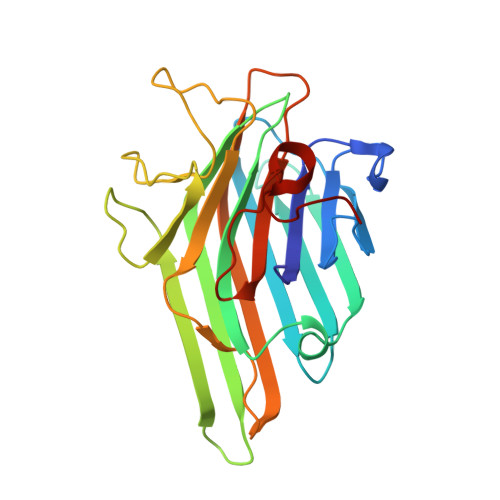Structural characterization of a lectin from Canavalia virosa seeds with inflammatory and cytotoxic activities.
Osterne, V.J., Silva-Filho, J.C., Santiago, M.Q., Pinto-Junior, V.R., Almeida, A.C., Barreto, A.A., Wolin, I.A., Nascimento, A.P., Amorim, R.M., Rocha, B.A., Delatorre, P., Nagano, C.S., Leal, R.B., Assreuy, A.M., Nascimento, K.S., Cavada, B.S.(2016) Int J Biol Macromol 94: 271-282
- PubMed: 27737777
- DOI: https://doi.org/10.1016/j.ijbiomac.2016.10.020
- Primary Citation of Related Structures:
5F5Q - PubMed Abstract:
A lectin from Canavalia virosa, Diocleinae subtribe, was purified by affinity chromatography with Sephadex G-50 matrix and named ConV. The primary structure of ConV was obtained by mass spectrometry and crystals were obtained by the vapor diffusion method at 293K and belonged to orthorhombic space group P2 1 22 1 with two molecules in its asymmetric unit. The structure obtained presented R factor and R free of 18.91% and 24.92% respectively, with no residues in nonallowed regions of Ramachandran plot. The crystal structure was solved at 2.53Å and was demonstrated to be very similar to other lectins from the same subtribe. In inflammatory tests, ConV elicited paw edema, but incubation of lectin with glucose beforehand was able to reduce the edematogenic effect, indicating the involvement of the carbohydrate recognition domain in this process. The lectin also showed toxicity to rat C6 glioma cells, disrupting the mitochondrial membrane potential (ΔYm) and decreasing cell viability, indicating an anticancer potential for ConV. In silico studies confirmed that ConV interacts strongly with carbohydrates that comprise the N-glycans of glycoproteins. This finding corroborates the hypothesis which holds that the lectin domain interacts with glycans in molecular targets and that this contributes to the effects observed in biological activities.
- Universidade Federal do Ceará (UFC), Fortaleza, Ceará, Brazil.
Organizational Affiliation:



















